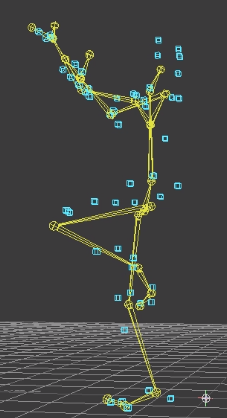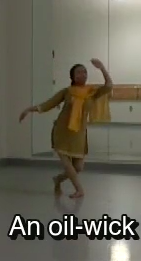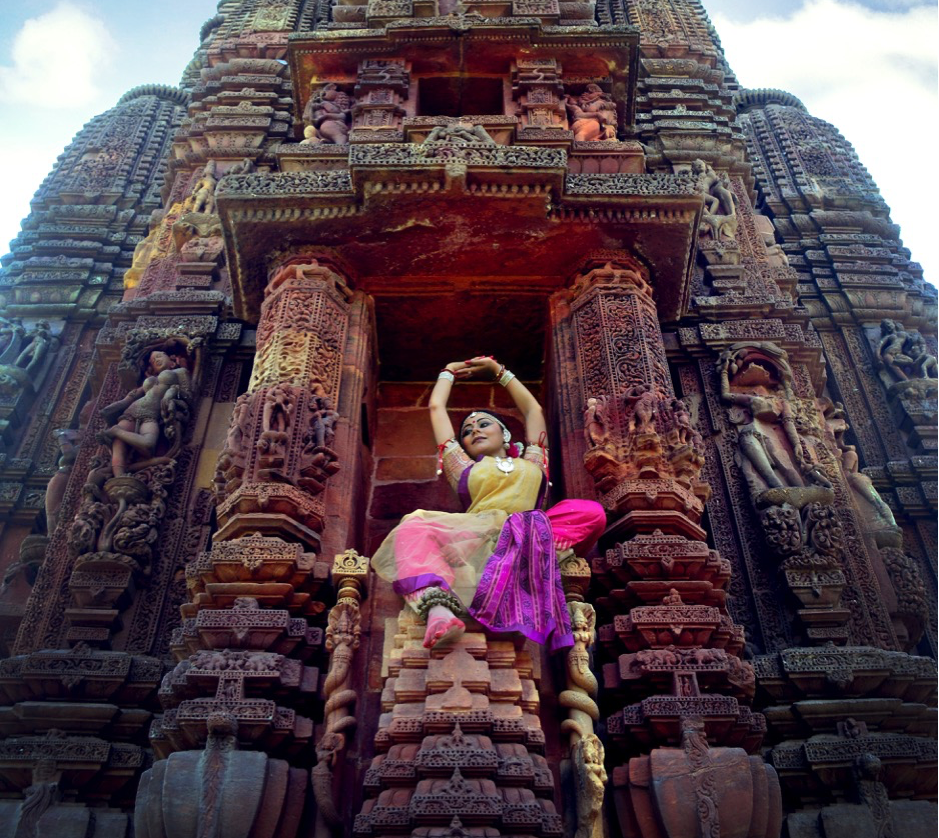Introduction



The opening videos are disorienting, unclear, ghostly. Figures move between stylized poses over other bodies (living, historical, and sculptural) in the background photo of the front of a temple. Two videos are perfectly in sync, and one is just a few steps behind—a duet distributed across three moving forms. Whose body is present? To whom does the movement belong? How can we make sense of these overlapping figures, and in what ways do they defy access?
This webtext is a critical reflection on work at the intersections of creative and scholarly digital practice. Kaustavi created digital motion capture of her dance in video and 3D animation, and Erin created a digital stage to showcase Kaustavi's videos and both of their reflections on the making process. Beyond this, though, this webtext is also an account of our interdisciplinary collaboration over several years, and what we've learned from the process that might be of interest to the computers and writing community. We come together through shared interest in digital design and culture, but via different disciplinarily informed methods and conversations.
This project curates three artistic transpositions of Odissi, an eastern Indian classical dance form, from live movement to digital embodiment. It is a theoretically informed stage for composing the dancing body in digital space where the kinesthetic is centered in concept, execution, and design. At its heart is an Odissi practitioner and scholar, Kaustavi Sarkar, who recorded a segment of her Odissi dance performance using motion-capture (mocap) technology. Once the movement data was captured, she explored a range of choices for translating the moving body in 3D simulation, joined by collaborators in professional animation, fashion design, and multimedia scholarship. We investigate three representations of Kaustavi's recorded movement data and explore these variations' affordances and constraints as online avatars for the embodied Odissi dancer. These performances are framed by Kaustavi's reflections on her experience as both dancer and digital composer, along with consideration of the issues at stake in capturing and representing the Odissi dancing body.

We highlight our diverging approaches to this data as both creative scholar-practitioners, one in dance and one in digital media. We approach the videos with different questions; Kaustavi considers their affordances and constraints for representing Odissi motion, and in particular for referencing the historically marginalized Mahari (the historical temple-dancer) body, while Erin (as a digital writing scholar, designer, and cultural outsider) considers the ways in which the videos negotiate access to the performed Odissi narrative, particularly in light of recent experiments with integral and experimental captions in digital media studies.
We offer several routes through this project. The three videos are located in the center to highlight their importance; we encourage readers to stop and view these first, along with Kaustavi's description underneath, and to move between the reflective materials and these videos. Moving along the left side gives Kaustavi's perspective on the project: its grounding in Odissi tradition, history, and theory; intersections between dance and motion capture; the process of capturing movement data; and her experiences at the intersections between dance and digital composing. Moving along the right side gives Erin's perspectives on the project: how she enters into collaboration with Kaustavi; questions of accessing materials outside her knowledge and experience; her work as digital developer in designing the webtext-as-stage. (Note: These links are provided above on narrower screens.) We close with takeaways for Odissi and digital composing, as well as for performing digital ethnography in the contexts of digital writing studies, and offer takeaways that we've learned from our interdisciplinary collaborative process. At the bottom of the page are our references, as well as a glossary for terms related to Odissi and classical Indian dance.
Our collaborative project alternates between individual and collective perspectives. We write in the collective voice for our opening and closing sections, to emphasize our collaborative approach to this project. However, each of our separate sections are written individually in our own voices (although informed by our ongoing conversations). We seek to bring our different voices and scholarly approaches into collaborative conversation by preserving and interweaving our different motivations and scholarly artifacts (videos, webtext, reflective writing), rather than speaking throughout in a unified voice. As part of our different disciplinary approaches and investments, we also talk about "technology" and "digital media" from different perspectives; Erin, for example, emphasizes "digital media" based on her practice and grounding as a digital writing scholar. Kaustavi, on the other hand, emphasizes "technology" as a way of expanding understandings of technology as a continuum that includes the dancing body and the stone sculpture, with digital motion-capture tools as one way of augmenting her technological approach to the moving Odissi body. We also consider it important to include the cultural and theoretical context out of which Kaustavi’s motion-capture videos originally emerged, as this context is essential to understanding these videos as digital writing artifacts.
In particular, we highlight several lenses that inform our approach to these videos: access, multimodality, gesture, and culture. These lenses emerged out of our collaborative, interdisciplinary conversation as common ground of importance to both of our fields and our own investments in this project. We expand on these lenses in greater detail in our separate discussions, then come together at the end with implications informed by these lenses for audiences of writing scholars, dance scholars, and those engaged in collaborative digital humanities projects across disciplines.